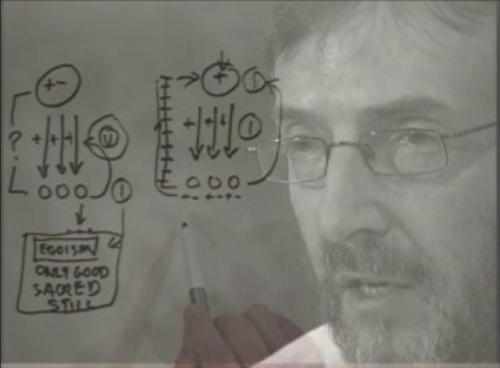A chunk of the ongoing debate over at Scott Bakker’s blog for my own perusal. I need to plant landmarks on a sprawling discussion, or I get lost too easily and forget the path I went through just now. Lost in the labyrinth and food for the minotaur.
Bakker’s quote:
The dilemma is one of global absurdity. There’s the idea of the sum of human culture up to this moment becoming as quaint and childish and incomprehensible as cave paintings. There’s the idea that the entirety of thought and assumption revolving around responsibility and obligation and [enter ubiquitous normative term] is simply false. There’s the idea that all our social institutions are in some way derived from and dependent upon these concepts and will collapse with them. Need I go on?
I fear it is inevitable, but what’s there to do other than fight or embrace quietism (either in the form of fantasy or nihilism)?
The only way to mobilize people, however, is to convince them the threat is real. But the world is a circle with as many centres as there are people. Everyone has their own redeeming (or exculpating) story – be it New Age, religious, or intellectual – which for them is the baseline, the yardstick they use to make sense of, let alone measure, everything. One of my tactics to make a second order ‘diaphonic’ critique, to observe the diverse, mutually incompatible redemptive views, and to contrast them to the breathtaking theoretical solidarity you find in science.
My part:
—
If I understand this correctly it’s about a form of split between perceived norm and common values, and actual truth (as “revealed” by science). But I was reading of a similar split in the book of Von Foerster, a split that happened already a while ago (and the new one could be just a repetition of it under a new form, or its prosecution).
Here’s the quote:
The scientific conception of reality which emerged in the 17th century is, in large part, responsible for our love affair with causality. “Newton gave the world the first rigorous formulation of the doctrine of causality. Most simply, the doctrine asserts that the same causes generate the same effects.” […]
The doctrine of causality appeared to fulfill man’s perennial search for certainty and objectivity. […] as Robert J. Oppenheimer explains, “The giant machine (the Newtonian universe) was objective in the sense that no human act or intervention qualified its behavior.” […]
And here’s the opening of the dilemma:
Although relativity theory and quantum mechanics have radically altered the physicist’s view of reality, this shift has not touched the average person. Equally, if not more important, many scientists have also failed to revise their thinking about reality and the nature of scientific work. Thus, most people see the world like the 17th century scientists, assuming that it’s possible to have objectivity and to know reality.
Why is it so?
Our 17th century mentality manifests itself in daily life. If this last statement sounds outlandish, stop and consider: Have you recently repaired some mechanical device, gathered data about the stock market, settled a dispute, checked your child’s homework, or sat in a jury? Or, perhaps you earn your living testing new drugs, designing computers, practicing law, or investigating insurance claims? These activities and countless others require gathering data or information – not just any data, but data that are correct or accurate, i.e., that are true.
It’s a practical need of daily life, for which the Newtonian principles are just enough to be functional. “It works.” And the developments of science that are most destabilizing (for theoretical models) are those that actually don’t have much impact on the everyday life.
It’s like the discussion about why believing in science. Because it works. But quantum theory or consciousness seen as a mere process, “do not work”. They have no practical use in daily life. They don’t give you Jedi powers.





